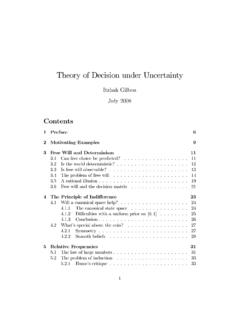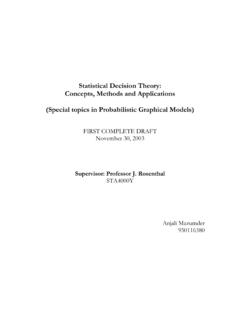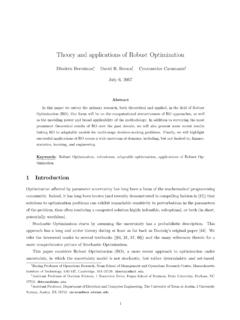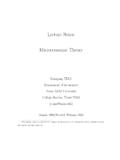Transcription of This PDF is a selection from an out-of-print volume …
1 This PDF is a selection from an out-of-print volume from the NationalBureau of Economic ResearchVolume Title: Economics of the Family: marriage , Children, and HumanCapitalVolume Author/Editor: Theodore W. Schultz, Publisher: University of Chicago PressVolume ISBN: 0-226-74085-4 volume URL: Date: 1974 Chapter Title: A theory of MarriageChapter Author: Gary S. BeckerChapter URL: pages in book: (p. 299 - 351)A theory of MarriageGary S. BeckerUniversityof Chicago and National Bureau of Economic ResearchI1. IntroductionIn recent years, economists have used economic theory more boldly toexplain behavior outside the monetary market sector, and increasingnumbers of noneconomists have been following their examples. As aresult, racial discrimination, fertility, politics, crime, education, statisticaldecision making, adversary situations, labor-force participation, the usesof "leisure" time, and other behavior are much better , economic theory may well be on its way to providing a unifiedframework for all behavior involving scarce resources, nonmarket as wellas market, nonmonetary as well as monetary, small group as well , one type of behavior has been almost completely ignored byeconomists,t although scarce resources are used and it has been followedin some form by practically all adults in every recorded society.
2 I refertO marriage . Marital patterns have major implications for, among otherthings, the number of births and population growth, labor-force participa-tion of women, inequality in income, ability, and other characteristicsamong families, genetical natural selection of different characteristicsI benefited from the discussion of several earlier drafts of this paper at the Workshopin Applications in Economics of the University of Chicago and in seminars at theNational Bureau of Economic Research, Northwestern University, and the PopulationCouncil. Very helpful suggestions were received from William Brock, Isaac Ehrlich,Alan Freiden, H. Gregg Lewis, Robert T. Michael, Marc Nerlove, Richard Posner,George J. Stigler, T. W. Schultz, and two referees. Michael Keeley provided valuableresearch assistance. Research was supported by a grant from the Ford Foundation tothe National Bureau of Economic Research for the study of the economics of paper is not an official NBER publication since it has not been reviewed by theNBER Board of Directors.
3 'To the best of my knowledge, the only exception prior to my own work is an un-published paper by Gronau (1970a). His paper helped stimulate my interest in S. BECKERIATHEORY OF marriage over time, and the allocation of leisure and other household , the neglect of marriage by economists is either a major over-sight or persuasive evidence of the limited scope of economic this essay, it is argued that marriage is no exception and can besuccessfullyanalyzed withinthe framework provided by moderneconomics. If correct, this is compelling additional evidence on the unify-ing power of economic simple principles form the heart of the analysis. The first is that,since marriage is practically always voluntary, either by the personsmarrying or their parents, the theory of preferences can be readilyapplied, and persons marrying (or their parents) can be assumed toexpect to raise their utility level above what it would be were they toremain single. The second is that, since many men and women competeas they seek mates, a market in marriages can be presumed to exist.
4 Eachperson tries to find the best mate, subject to the restrictions imposed bymarket two principles easily explain why most adults are married andwhy sorting of mates by wealth, education, and other characteristics issimilar under apparently quite different conditions. Yet marital patternsdiffer among societies and change over time in a variety of ways thatchallenge any single theory . In some societies divorce is relatively com-mon, in others, virtually impossible, and in Western countries it hasgrown rapidly during the last half-century. Some societies adjust to legaldifficulties in receiving divorces by delaying marriage , whereas othersadjust by developing more flexible "consensual," "common-law," or"trial" marriages. In many the bride brings a dowry, in others the groompays a bride-price, and in still others couples marry for "love" and disdainany financial bargaining. In some the newly married usually set up theirown household, in others they live with one set of not pretend to have developed the analysis sufficientlytoexplain all the similarities and differences in marital patterns acrosscultures or over time.
5 But the "economic" approach does quite well,certainly far better than any available It is hoped that thepresent essay will stimulate others to carry the analysis into these 2 of Part I considers the determinants of the gain from marriagecompared to remaining single for one man and one woman. The gain isshown to be related to the "compatibility" or "complementarity" of theirtime, goods, and other inputs used in household 3 of Part I considers how a group of men and women sort them-selves by market and nonmarket characteristics. Positive assortive mating a positive correlation between the values of the traits of husbands and wives is generally optimal, one main exception being the sorting by the earn-2 Someof the best work has been done by Goode (1963), but there is no systematictheory in any of his fine power of men and womeEmpirically, positiveto IQ, education, height, atother 4 of Part I considerdivided between the husbandat 50 50, or determineddemand for different kinds oPart II develops varioussimple analysis in this optimal sorting and thedetermining the incidenceconsidered.
6 The assumptioare known with certaintymates, delays in marriage ,Divorce and the durationments made during marriaother ways. Also briefly exppatterns for fertility, genetfamily incomes and home2. The Gain from MarriageThis section considers twoto marry each other orsimply means that they shaoccurs if, and only if, boththeir recent develoI assume that utility deppurchased in the marketeach Theyservices and partly with tMost important for preseor transferable amonghamong members of the saHousehold-produced COof meals, the quality acompanionship, love, anMore precisely, if they expwithcertainty. Part II discussestime spent searching for an amarital exposition of this appring power of men and women, where a negative correlation is , positive assortive mating is the most common and appliesto IQ, education, height, attractiveness, skin color, ethnic origin, andother 4 of Part I considers how the the total output of a household getsdivided between the husband and wife.
7 The division is not usually fixed, sayat 50-50, or determined mechanically, but changes as the supply of anddemand for different kinds of mates II develops various extensions and modifications of the relativelysimple analysis in this part. "Caring" is defined, and some of its effectson optimal sorting and the gain from marriage are treated. The factorsdetermining the incidence of polygamous marital arrangements areconsidered. The assumption that the characteristics of potential matesare known with certainty is dropped, and the resulting "search" formates, delays in marriage , trial marriage , and divorce are and the duration of marriage are also related to specific invest-ments made during marriage in the form of children, attachments, andother ways. Also briefly explored are the implications of different maritalpatterns for fertility, genetical natural selection , and the inequality infamily incomes and home The Gain from MarriageThis section considers two persons, M and F, who must decide whetherto marry each other or remain single.
8 For the present, " marriage "simply means that they share the same household. I assume that marriageoccurs if, and only if, both of them are made better off that is, increasetheir recent developments in the theory of household behavior,I assume that utility depends directly not on the gdods and servicespurchased in the market place, but on the commodities produced "by"each They are produced partly with market goods andservices and partly with the own time of different household important for present purposes, commodities are not marketableor transferable among households, although they may be transferableamong members of the same commodities are numerous and include the qualityof meals, the quality and quantity of children, prestige, recreation,companionship, love, and health status. Consequently, they cannot beMore precisely, if they expect to increase their utility, since the latter is not knownwith certainty. Part II discusses some consequences of this uncertainty, especially for thetime spent searching for an appropriate mate and the incidence of divorce and othermarital exposition of this approach is given in Michael and Becker (1973).
9 A theory OF MARRIAGE301 IGARYS. BECKERI other household is either a major over-ope of economic no exception and can beorkprovided by modernional evidence on the unify-ie analysis. The first is that,ary, either by the personspreferences can be readilyarents) can be assumed toit would be were they tomen and women competebe presumed to exist. Eachthe restrictions imposed byost adults are married andand other characteristics isitions. Yet marital patternsin a variety of ways thatdivorce is relatively corn-Western countries it hassocieties adjust to legalmarriage, whereas otherssual," "common-law," ordowry, in others the groomarry for "love" and disdainriarried usually set up theirt of sufficientlytomarital patterns acrosspproach does quite well, It is hoped that thealysis into these unchartedof the gain from marriageone woman. The gain iscomplementarity" of women sort them-Positive assortive mating raits of husbands and wivesthe sorting by the earn-butthereis no systematic302 GARYS.
10 BECKER identified with consumption or output as usually measured: they covera much broader range of human activities and aims. I assume, however,that all commodities can be combined into a single aggregate, denotedby Z. A sufficient condition to justify aggregation with fixed weights isthat all commodities have constant returns to scale, use factors in the sameproportion, and are affected in the same way by productivity-augmentingvariables, such as education. Then different commodities could beconverted into their equivalent in terms of any single commodity byusing the fixed relative commodity prices as These weightswould be independent of the scale of commodity outputs, the prices ofgoods and the time of different members, and the level of utility thus becomes equivalent for each person to maximiz-ing the amount of Z that he or she receives. Moreover, my concentrationon the output and distribution of Z does not presuppose transferableutilities, the same preference function for different members of the samehousehold, or other special assumptions about household has a production function that relates its total outputof Z to different inputs:Z =f(x1.)


















